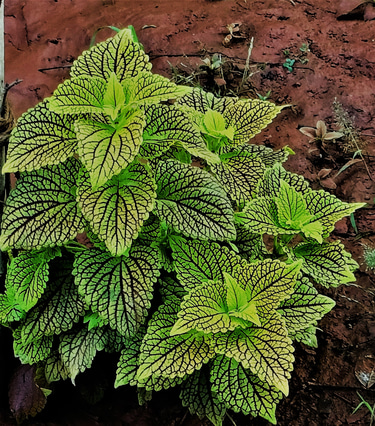Cultivation of Betel Leaf Vine
The leaves are part of religious and social occasions in most of the household. Consuming the leaves with other ingredients like betel nuts, lime, sometimes with tobacco is an age old practice. As incited in some references, it was an important article of trade in Bengal even during British period. Essential oil extracted from betel leaves has huge economic importance in pharma and aroma industries. Both fresh leaves and essential oils have export potentials.
CROP CULTIVATION
9/24/20245 min read
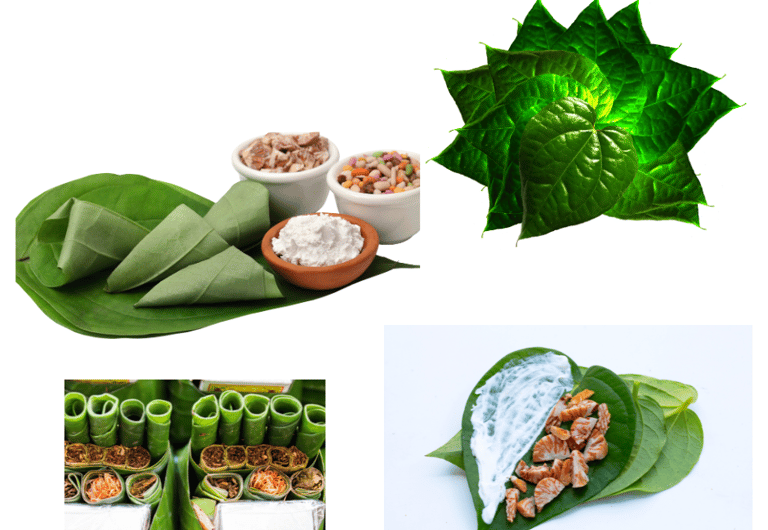

Betel Leaf Vine
The betel leaves, in the shape of the heart, offered to win the heart of the others, usually the guests, in country like India and may be in its neighborhood. The leaves are part of religious and social occasions in most of the households. Consuming the leaves with other ingredients like betel nuts, lime, sometimes with tobacco is an age old practice. As incited in some references, it was an important article of trade in Bengal even during British period.
Essential oil extracted from betel leaves has huge economic importance in pharma and aroma industries. Both fresh leaves and essential oils have export potentials.
Cultivation of betel vine holds good for in small and marginal land holdings. Even in small pieces of land or even at kitchen garden may be engaged with betel vines growing.
Betel leaf vine , of scientific name Piper betle, L, belongs to family Piperaceae. It is a woody vine, creep along the ground or climbs up the support with the help of adventitious or areal roots.
As a commercial cultivation, of betel vine for harvesting of leaves is still looks a lucrative venture. India is the largest producer of betel leaves followed by Bangladesh, Shri Lanka, Malaysia, Madagascar and West Indian Islands. In India, Karnataka, Kerala and Assam are the major contributor to the total production. States like Maharashtra, Bihar, Gujarat, Andhra Pradesh are the other states where betel vines are cultivated.
Cultivation of Betel Leaf Vines:
Climate and Soil: Betel vine is a wet and humid tropic plant which needs well distributed fair amount of rail fall. Plants love bright sun and higher temperature, 70-80% of relative humidity. Any kind of soil rich in humus. bit porous, as in case of coastal and sub-mountain region are preferred for cultivation.
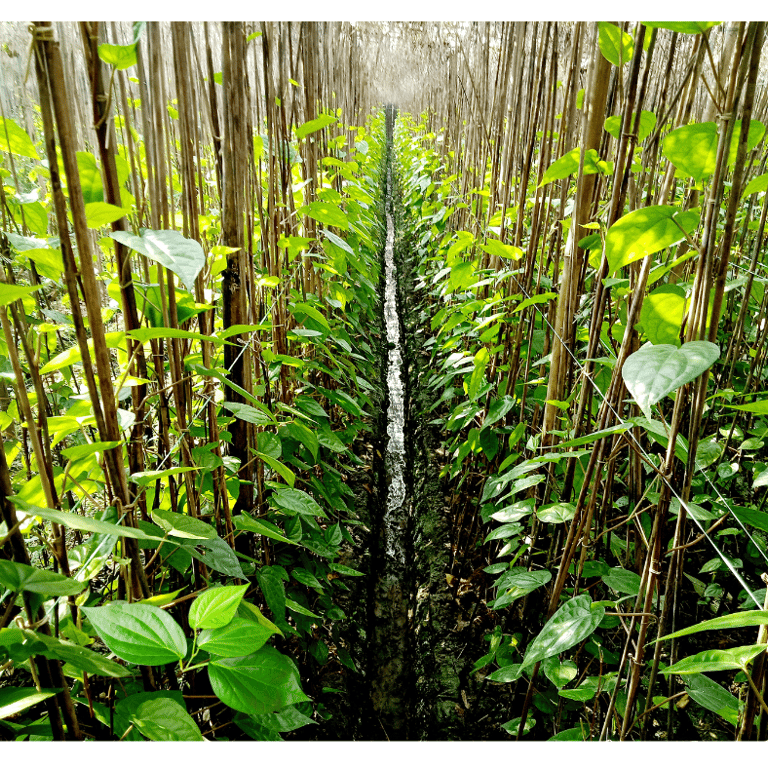
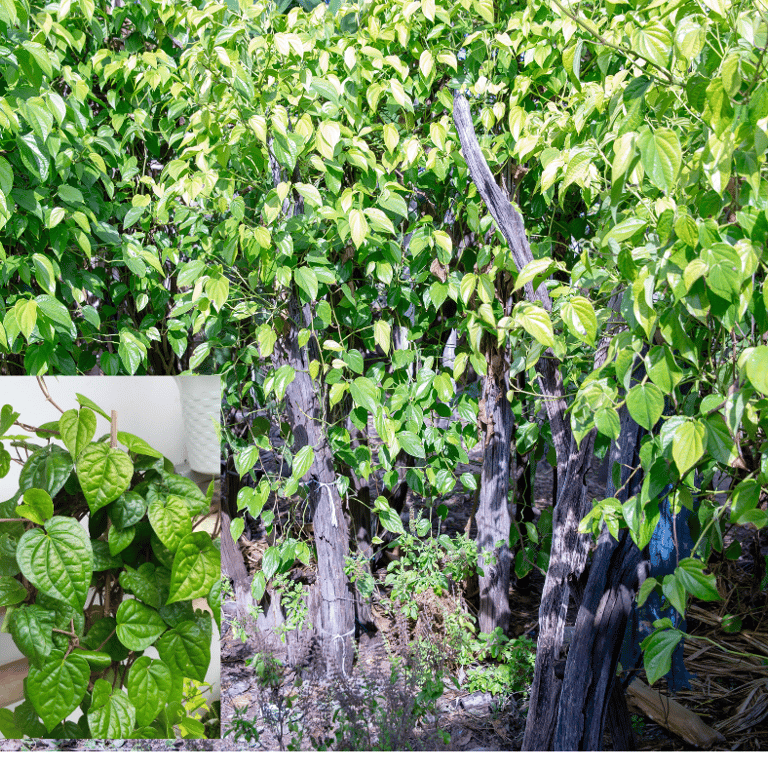
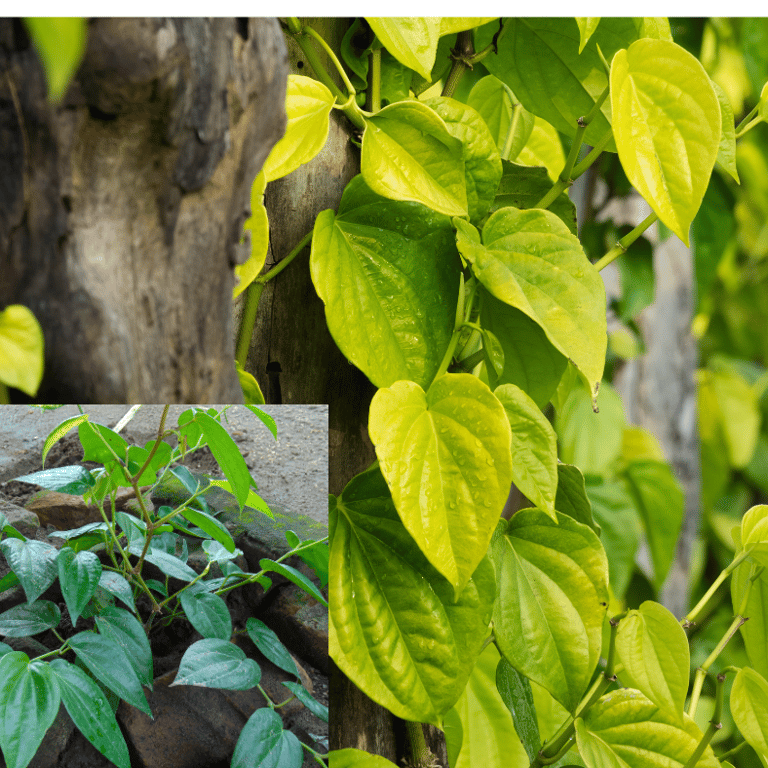
Propagation and cultivation: There are different way to cultivate betel vine, either in a baroj or bareja or as cultivation with the help of live supports or sometimes in poly-houses. Cultivation in Baroj is of a conventional kind. Baroj or bareja is a small thatched structure formed with the help of bamboo sticks or wooden poles. Vines are made to climb to bamboo to reach the roof and spread over it.
Betel vine cultivation also involves cultivation of supporting tree on one hand and betel vines on the other. Firstly, supporting plants preferably Agathi (Sesbania grandiflora) are planted at a convenient distance. They are topped on reaching 4 m height. Setts are the cutting obtained from apical shoots of the vines. setts with abundant areal roots and axillary buds are chosen to prepare the cuttings of length 1-1.5 ft. Propagated setts are planted around the live support. The branches of live support are trimmed at the height of 2 m to enable the the vines climb it easily. Instead of Agathi as live support, crops like Areaca trees can also be used.
Betel vines can be cultivated successfully in poly-houses. Advantages of poly-house cultivation is early to start leaf yield, with in a span of 3 months. Leaves produced are bigger, healthy and succulent. Orchards yield for relatively longer period of 10 years. In poly-house bamboo sticks are planted at a distance 1-1.5 X 4 ft. Later cutting are planted accordingly.
After care in betel vine cultivation:
Some of the important things are to be kept in mind in cultivation of betel vine for good leaf harvest. They may be proper manuring and irrigation, training of vines and live support, lowering of vines.
In case of training, vines are fixed on live support with the help of banana threads at a distance of 15-20 cm. The process is performed once in fortnight. Supporting trees are trained by trimming their branches at the height of 2m for easy climbing of vines. Lowering of vines is another important aspect to harvest healthy and broader leaves, where vines are lowered to the height of 3 m, beyond which leaves produced are of lesser size. Once the vine reaches the height of 3 m, tip of the vines are cut and allowed to produce more tillers and leaves.
Diseases affecting betel vines:
Anthracnose: Otherwise known as leaf spot disease, characterized by appearance of light to dark irregular spots surrounded by yellow halo. In advanced condition blackish lesion appear even on stem. The condition can be controlled by the spray of 0.5% of Bordeaux mixture or 0.2% ziram just after leaf harvest.
Bacterial Wilt: Here, leaves of the plant show gradual yellowing and wilting of vines. Can be controlled by soaking the planting material with Streptocycline 500 ppm or Bordeaux mixture 0.5 %. Drench the Bordeaux mixture 0.25% around the vine at monthly intervals.
Sectorial wilt or Collar rot: In this case, vines show discoloration and rotting at the stem and root portion touching the soil. Leaves become yellow and wither. Leaves of young vines show water soaked lesions which appears at the edge and enlarge fast towards the middle. The symptoms can be controlled by Spray Streptocycline @ 400 ppm + Bordeaux mixture @ 0.25% at the appearance of first disease symptoms. In severe conditions, it is recommended to collect and destroy affected leaves or vines.
Powdery mildew of the vines: The disease is symptomized by appearance of whitish powdery source on both the surface of leaves. Symptoms mainly appears on young shoots and leaves. Affected leaves and shoots show distortion and deformation. Under severe condition whitish mass turns into brown blotches and leaves start yellowing and fall off. Disease is more common in humid condition during June to August. Spraying with wettable Sulphur @ 0.2 % or dusting with Sulphur @ 25kg/ha will take care of the disease.
Insect pests affecting Betel vine:
Sap sucking pests: Many of sucking pests like mealy bugs, Aphids, Scales and thrips affects the betel vines. They suck the sap from leaves, buds and tender shoots to make the plant wither, loose vigor and affect the leaf yield. These insects are taken care of by the spraying of Chlorpyriphos 20 EC @ 2 ml/lit or Malathion 50 EC @ 1ml/lt.
Red Spider mite (Tetranychus sp.): Red spider mite colonize at lower surface of leaves with silken webs. They feed on leaves by sucking the sap. Affected leaves shows punctures on its surface and turn to pale yellowish color affecting the merchantability of leaves. The insect activities reduced by spray with insecticidal soaps or spray with dicofol @ 1ml/lt or spray with 2 % neem oil.
Betel vine bug (Dispunctus politus): They feed on leaves by puncturing and sucking the sap. The affected leaves shows blackish spot and withering. The insets are managed by spraying with Malathion 50 EC @ 1- 1.5 ml/lt.
Leaf eating Caterpillar (Spodoptera litura): The insect otherwise known as cut worms, a voracious leaf feeder. It is a nocturnal and skeletonize the leaves by feeding. The insect menace can be controlled by the spray of neem oil @ 2% emulsion or 5% neem seed extract or spraying with Malathion @ 0.5ml/lt.
White flies (Aleurocanthus rugosa): These are pale yellowish bodied flies covered with powdery mass. Both nymph and adult are sap sucking. They congregate in large number and secrets honey dew to cause sooty mould. Affected vines loose vigor and start to wither.
Newsletter
Sign up for our newsletter and get notified about all new posted articles.
ADDRESS
House No. 2-113(P), Visnumurthynagar, Kelarkalabettu, Thenkanidiyuru, Udupi
cONTACT
7975809540
satishmqc362@gmail.com
